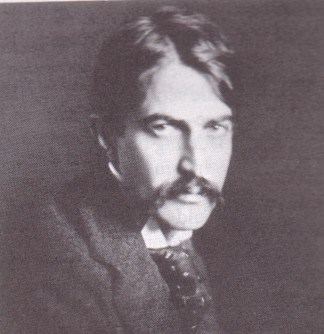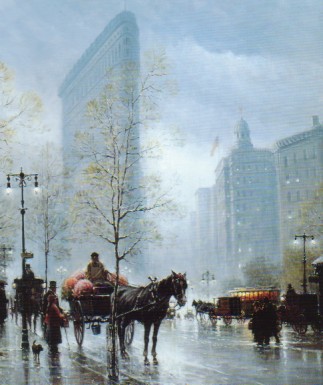|
● Early
Fiction
● Transcendentalists
● Power
of Imagination
● New
Visions of America
● Reform
and Liberation
● Regionalism
● A
New Wave
● Sympathetic
Views
● Rebellious Spirit
● The
Modernists
● The Lost Generation
● Harlem Renaissance
● New
Drama
● Depression,
Realism and Escapism
● Postwar Voices
and the "Beat Generation"
● New American
Voices
A New Wave
 As
the wounds of the Civil War slowly healed, many Americans became
discontented with the growing materialism
of society in the United States. Henry
James (1843-1916), an American who lived in Europe, examined
American society by observing the divergence
between American and European culture in novels like The American
and Portrait of a Lady. As
the wounds of the Civil War slowly healed, many Americans became
discontented with the growing materialism
of society in the United States. Henry
James (1843-1916), an American who lived in Europe, examined
American society by observing the divergence
between American and European culture in novels like The American
and Portrait of a Lady.
 "Regional"
writers began to drop their narrow provincial
focus, while still using realistic descriptions of everyday life.
As they concentrated increasingly upon the grimmer aspects of reality
and a deterministic
view of life, they were called "naturalists,"
linking them to European naturalists such as French novelist Emile
Zola. Again, William Dean Howells led the American realistic
movement, both with his magazine criticism and with his own novels,
such as The Rise of Silas Lapham (1885), a probing
but sympathetic portrait "Regional"
writers began to drop their narrow provincial
focus, while still using realistic descriptions of everyday life.
As they concentrated increasingly upon the grimmer aspects of reality
and a deterministic
view of life, they were called "naturalists,"
linking them to European naturalists such as French novelist Emile
Zola. Again, William Dean Howells led the American realistic
movement, both with his magazine criticism and with his own novels,
such as The Rise of Silas Lapham (1885), a probing
but sympathetic portrait
 |
|
Stephen Crane
|
of an American businessman. Stephen
Crane's(1871-1900) Maggie, A Girl of the Streets,
in 1893, and Theodore
Dreiser's (1871-1945) Sister Carrie, in 1900, were
considered shocking because they described young urban women who
fell into sexual sin. Crane's next novel, The Red Badge of Courage
(1895) was set during the Civil War. By limiting itself to a young
soldier's confused impressions of battle, it became the first impressionistic
novel in America. Upton
Sinclair's The Jungle (1906) exposed the horrible lives
of meat-packing
factory workers. Jack
London's Call of the Wild (1903), the tale of a sled dog, was set in the snowy wilderness
of the Northwest, where the discovery of gold had caused a rush
of greedy prospectors.
In this novel and other celebrated tales set in Alaska and in the
South Pacific, London expressed his sense that primitive
urges underlie all of life, reducing even humans to the level of
animals.
 While
these controversial books disturbed the reading public, other writers
were quietly exploring the fate of the individual. After the turn
of the century, Henry James, still living in Europe, wrote three
brilliant novels, The Wings of the Dove, The Ambassadors
and The Golden Bowl, in which he plunged deep into the characters
and personalities of his subjects. These were chiefly wealthy, cultured
Americans living in Europe, but, like the lower-class characters
of the naturalists' novels, James' people were trapped in their
environment, struggling to find happiness. James' interest was psychological
rather than social, however. Recording the most minute
details of perception,
he drew his readers close to his characters' mental and emotional
processes. His writing style became increasingly complex, but this
led attention away from action
and setting
and onto what the characters were feeling. While
these controversial books disturbed the reading public, other writers
were quietly exploring the fate of the individual. After the turn
of the century, Henry James, still living in Europe, wrote three
brilliant novels, The Wings of the Dove, The Ambassadors
and The Golden Bowl, in which he plunged deep into the characters
and personalities of his subjects. These were chiefly wealthy, cultured
Americans living in Europe, but, like the lower-class characters
of the naturalists' novels, James' people were trapped in their
environment, struggling to find happiness. James' interest was psychological
rather than social, however. Recording the most minute
details of perception,
he drew his readers close to his characters' mental and emotional
processes. His writing style became increasingly complex, but this
led attention away from action
and setting
and onto what the characters were feeling.
 |
|
New York in Wharton's
Time
|
 Edith
Wharton (1862-1937) was one of James' close friends and
literary followers. She came from a socially prominent New York
family and had married into an equally important Boston family.
This high-toned
social circle disapproved of her writing, but eventually she defied
her peers
and produced insightful
novels and stories. One of her finest books, The
House of Mirth (1905), tells
the tragic story of a fading beauty hunting desperately for a rich
husband and falling victim to the hypocritical high society of New
York.The Age of Innocence (1920) is another successful
novel written by Wharton, who exposed her upper-class world as only
an insider could. Edith
Wharton (1862-1937) was one of James' close friends and
literary followers. She came from a socially prominent New York
family and had married into an equally important Boston family.
This high-toned
social circle disapproved of her writing, but eventually she defied
her peers
and produced insightful
novels and stories. One of her finest books, The
House of Mirth (1905), tells
the tragic story of a fading beauty hunting desperately for a rich
husband and falling victim to the hypocritical high society of New
York.The Age of Innocence (1920) is another successful
novel written by Wharton, who exposed her upper-class world as only
an insider could.
Previous Page Next
Page
|

